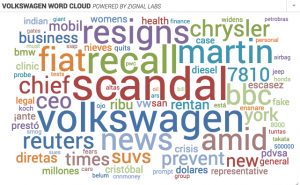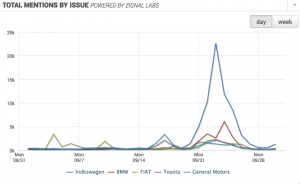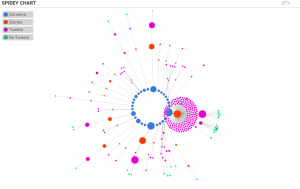For every enterprise, brand or organization, a crisis always looms as a persistent — yet inevitable — threat on the horizon. In today’s digitally-fueled world, the tiny spark of a crisis can erupt into a massive fire overnight, leaving a corporate brand and reputation in a heap of smoldering ashes. For a global enterprise that has built tremendous brand equity across its product portfolio, a crisis can translate into lost sales and public trust, and erosion of shareholder value.
Consider the recent crisis that Volkswagen faced. In September, 2015, Volkswagen suffered the wrath of the global community after disclosing that the company’s diesel cars were designed to cheat on tailpipe-emissions tests. In an interview with the New York Times, Hans-Gerd Bode, Volkswagen’s communications chief described the crisis as a “tsunami.” The fallout across digital and social channels was swift and decisive: Americans’ attitudes toward the “100 most visible companies” ranked Volkswagen dead last, according to a recent Harris Poll.
You can see the immediate effect on the global conversation in the Word Cloud in figure 1. When Volkswagen disclosed the news, the conversation spread and was visibly seen as a “scandal” in the automotive community.

Proactive enterprises have planned ahead by creating comprehensive crisis communications plans. Yet, many of these best-intentioned plans can’t withstand the ferocity and force of a digitally-driven crisis. Since 2011, Zignal Labs has worked with hundreds of large enterprise brands, leading sports teams and renowned political leaders. Based upon Zignal’s experiences, three trends ring true for every modern crisis:
- A modern crisis is fueled by data: In today’s modern marketplace, companies are inundated with massive amounts data. In fact, major enterprises manage petabytes of big data every day. This influx of data grows exponentially due to the rapid proliferation of mobile devices and the digitization of consumers — generating an incredible 2.5 quintillion bytes of data every day.
 While the nature of a crisis hasn’t changed (i.e. an embarrassing public CEO flub or a global product recall), the digital channels through which a crisis will spread are fast and ferocious. For any crisis – both small and large – brands must be prepared for the massive volume, velocity and variety of digital information that comes in its wake. In the case of Volkswagen, the Total Mentions Chart in figure 2 illustrates the volume and velocity of conversations associated with the scandal that quickly spiked within a span of a few days.
While the nature of a crisis hasn’t changed (i.e. an embarrassing public CEO flub or a global product recall), the digital channels through which a crisis will spread are fast and ferocious. For any crisis – both small and large – brands must be prepared for the massive volume, velocity and variety of digital information that comes in its wake. In the case of Volkswagen, the Total Mentions Chart in figure 2 illustrates the volume and velocity of conversations associated with the scandal that quickly spiked within a span of a few days. - Conventional approaches no longer work: In a modern crisis, the volume, velocity and variety of data will immediately overwhelm traditional tools and processes. Even the best laid plans can’t adequately address the challenges associated with a crisis instantaneously unfolding and mutating across digital and mobile channels.
- Data provides the blueprint for a solution: While the data “tsunami” poses an immediate challenge for any crisis communications team, data will also provide a path to a solution. Specifically, data will reveal critical trends, patterns and insights in the wake of a crisis to empower communications, PR, public affairs and marketing teams.
 Figure 3 depicts a crisis that Apple faced during its recent controversy with the FBI to unlock an iPhone belonging to the San Bernardino terrorist, Syed Farook. Examining the clustering of stories from Zignal Labs’ Spidey Chart, communications teams can understand where the conversations are centered. The blue dots represent the domains and in this case, Techcrunch is a center of media activity, out of which is coming a single story (orange) that is being tweeted about significantly (pink). By understanding the anatomy of how a crisis is being syndicated across the media spectrum, communications professionals can ask for a retraction, correction or plan to address the issue through another vehicle.
Figure 3 depicts a crisis that Apple faced during its recent controversy with the FBI to unlock an iPhone belonging to the San Bernardino terrorist, Syed Farook. Examining the clustering of stories from Zignal Labs’ Spidey Chart, communications teams can understand where the conversations are centered. The blue dots represent the domains and in this case, Techcrunch is a center of media activity, out of which is coming a single story (orange) that is being tweeted about significantly (pink). By understanding the anatomy of how a crisis is being syndicated across the media spectrum, communications professionals can ask for a retraction, correction or plan to address the issue through another vehicle.
With an understanding that data will ultimately become a brand’s biggest threat during a crisis and a path to a solution, cross-functional teams must modernize their crisis communications plans accordingly.
To learn more about how you can modernize your crisis communications plan, attend Zignal’s informative breakout session at PRSA’s 2016 Internationl Conference, October 23-25 in Indianapolis. Zignal CEO Josh Ginsberg will discuss how enterprises can build their own data-driven crisis communication plan. Sign up here.
Zignal Labs turns media intelligence into a strategic asset for the world’s largest brands and enterprises. By analyzing the full media spectrum in realtime, Zignal’s centralized platform empowers public relations, communication and digital strategy professionals to analyze trends, pinpoint issues and make informed decisions. Headquartered in San Francisco with offices throughout the country, Zignal serves customers around the world including Airbnb, IBM, Citrix, Bacardi, Speaker of the House Paul Ryan, The Sacramento Kings, Brunswick Group and Fleishman Hillard. To learn more, visit: www.zignallabs.com








[…] […]